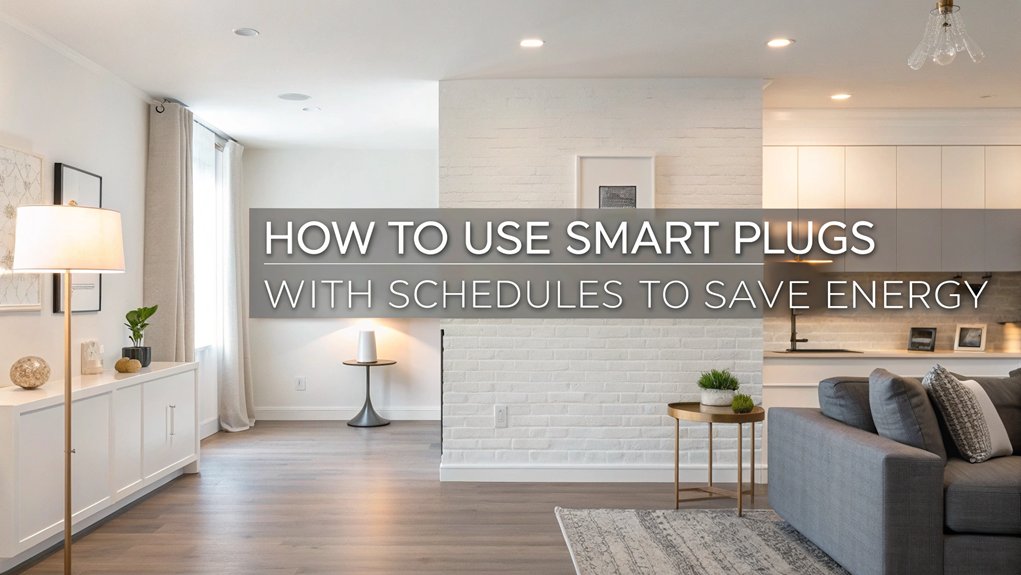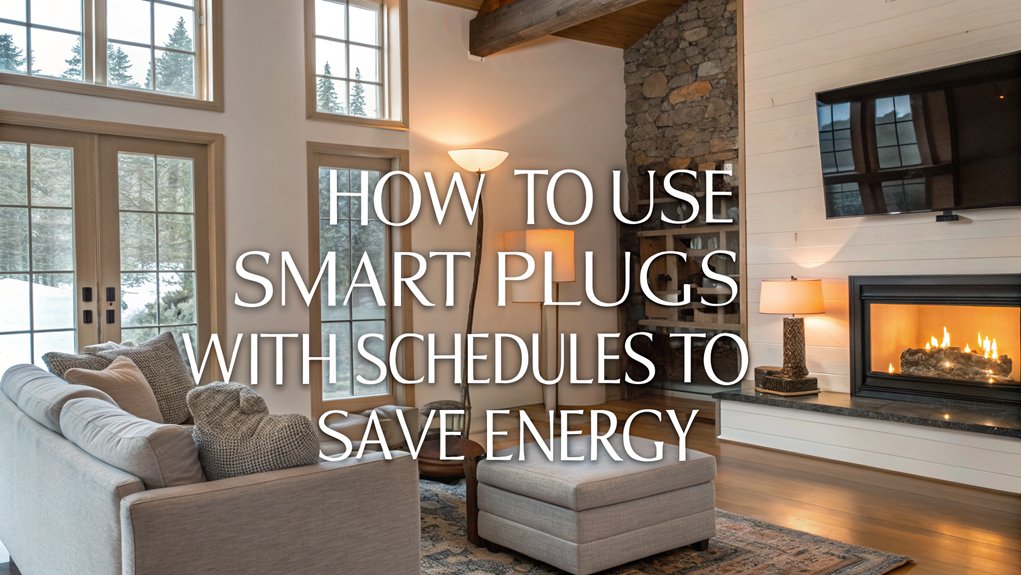To use smart plugs with schedules and save energy, download the plug’s app, set up unique on/off times, and automate device usage for non-peak hours. Leverage energy monitoring features to identify high-energy appliances, ensuring your plug is compatible with your smart home system (e.g., Amazon Alexa). Regularly analyze consumption patterns to refine schedules, reducing waste. Explore connecting virtual assistants for seamless control, revealing further insights into advanced automation and energy savings.
Key Facts Summarized
- Program on and off times for devices to avoid unnecessary energy consumption during non-use periods.
- Automate device schedules to operate during non-peak hours for reduced energy costs.
- Utilize energy monitoring features to track and adjust schedules based on usage patterns.
- Set smart plug schedules to turn off devices when no one is home to prevent energy waste.
- Regularly analyze energy data to refine schedules for optimal efficiency and savings.
Understanding Smart Plug Functionality
When you’re delving into the world of smart plugs, understanding their functionality is essential for optimizing energy use efficiently.
Smart plugs allow you to control your devices remotely, whether you’re at home or away. They enable you to turn the lights on or off using a mobile app or voice commands, seamlessly integrating into your smart home.
With scheduling capabilities, you can program devices to operate only when needed, reducing energy consumption and tackling vampire energy effectively.
By monitoring your home’s energy consumption, smart plugs offer insights into usage patterns, empowering you to save energy. Additionally, many smart plugs come with energy monitoring capabilities, which can help you track electricity usage and identify energy-hogging devices.
This precise control over energy flow diminishes waste, ensuring devices don’t draw power unnecessarily, making it easier to manage and enhance your home’s energy efficiency.
Selecting the Right Smart Plug for Your Home
As you begin selecting the right smart plug for your home, it’s vital to analyze key features that align with your energy-saving goals.
Opt for smart plugs with robust scheduling capabilities to automate devices, optimizing energy usage based on your daily patterns. Assess the amp load capacity for compatibility with appliances, avoiding overloads.
Energy monitoring features are important, enabling you to track power consumption and pinpoint inefficient devices. Make sure the smart plug integrates seamlessly with your smart home ecosystem, such as Amazon Alexa or Google Assistant, for streamlined control.
Prioritize those offering a user-friendly experience, as intuitive app functionality simplifies setting schedules and managing devices. Additionally, consider smart plugs that help eliminate phantom power to further enhance your energy savings.
Setting Up Smart Plug Schedules
Having identified the ideal smart plug for your home, it’s time to configure schedules that maximize energy efficiency.
Start by downloading the corresponding app, like the Cync app, and create an account. This gives you access to the scheduling features essential for managing energy usage.
Program specific on and off times for your connected devices to automate devices effectively. This reduces energy consumption by ensuring devices are off when not needed, combating vampire power drain.
Some advanced smart plugs even use machine learning to optimize schedules based on your habits. Additionally, integrating smart plugs with a whole-home energy monitor can provide valuable insights into energy consumption patterns, further enhancing your energy-saving efforts.
To further enhance energy efficiency, regularly monitor energy consumption data provided by the app. Adjust schedules as necessary, ensuring your smart plugs contribute to a more energy-efficient household.
Optimizing Energy Usage With Automation
Ever wondered how you can truly optimize your home’s energy use with smart plugs? By automating device schedules, you can greatly reduce energy consumption.
Smart plugs allow you to program connected devices to turn on and off at specific times, minimizing usage during non-peak hours. This scheduling can save you money, as most utility rates drop during these periods.
Additionally, smart plugs with energy monitoring capabilities let you analyze the power usage of each device, giving you insights to optimize further. You can also automate shutting devices off when no one’s home, reducing unnecessary energy drain. Furthermore, utilizing electricity usage monitors can help you identify which devices are consuming the most power, allowing for more targeted energy-saving strategies.
Integrating smart plugs with virtual assistants enhances this process, enabling voice control for seamless energy management and convenience in your daily routine.
Incorporating Smart Plugs Into Your Routine
While integrating smart plugs into your daily routine, you can markedly enhance energy efficiency and convenience. By automating devices like lamps and coffee makers, you establish energy-saving schedules that reduce consumption and cut costs. Smart plugs can be programmed to operate during off-peak hours, maximizing savings on utility bills. This method prevents vampire energy drain, which can account for 10% of energy consumption. With the Cync App, managing multiple smart plugs is seamless, allowing you to streamline and optimize your energy usage.
| Time of Day | Device | Action |
|---|---|---|
| Morning | Coffee Maker | Brew |
| Evening | Lamp | Turn On at Dusk |
| Night | TV | Power Off |
Incorporate smart plugs into your routine to enjoy enhanced convenience and significant energy savings.
Monitoring and Analyzing Energy Consumption
When you start using smart plugs with energy monitoring features, you gain the ability to track the power consumption of your connected devices in real time.
This monitoring lets you analyze energy consumption patterns, identify high-energy devices, and optimize electricity usage for substantial savings. By scheduling devices to run during off-peak hours, you can capitalize on reduced electricity rates.
- Identify high-energy appliances and adjust usage.
- Schedule devices to operate during off-peak hours for savings.
- Set notifications for excessive energy usage to prevent waste.
- Analyze data to raise awareness about vampire drain.
- Optimize electricity consumption by cutting power to idle devices.
Monitoring smart plugs helps you take control of your energy footprint, reducing waste and costs effectively. Additionally, integrating smart plugs with smart meter technology can further enhance your ability to monitor and manage energy usage efficiently.
Enhancing Safety and Convenience With Smart Plugs
Harnessing the power of smart plugs extends beyond energy savings to considerably enhance safety and convenience in your home.
Smart plugs allow you to schedule devices like space heaters to automatically turn off, reducing risks of fire hazards. By scheduling outdoor lights to switch on at dusk and off at dawn, you improve home security and deter intruders, all without manual intervention.
You can schedule appliances, such as curling irons and coffee makers, to operate at specific times, guaranteeing they don’t remain on unattended. Remote access to these scheduled devices means you can monitor and control them from anywhere, adding a layer of convenience.
This feature guarantees energy saving and peace of mind, as you can manage appliances even when away.
Frequently Asked Questions
How to Save Energy With Smart Plugs?
To save energy with smart plugs, program them to turn devices on and off at ideal times.
Use scheduling to minimize operation during peak hours, leveraging lower rates.
Smart plugs can cut power to idle devices, eliminating vampire drain, which accounts for about 10% of energy use.
Utilize energy monitoring features to identify high-energy devices and adjust usage.
Automate shutdowns when you’re away to further enhance energy efficiency.
Can You Set a Schedule on a Smart Plug?
You can definitely set a schedule on a smart plug. Start by downloading the smart plug’s app on your smartphone or tablet.
Open the app, find the scheduling feature, and select your desired on/off times. Most apps allow you to set different schedules for weekdays and weekends, giving you flexibility.
This precise control helps minimize energy waste by ensuring devices are only active when needed, reducing unnecessary power consumption and lowering your electricity bill.
Do Smart Plugs Use Electricity When Not in Use?
Even when idle, smart plugs sip electricity like a whisper in the wind. They typically consume less than 1 watt, a stark contrast to the hefty vampire drain of traditional devices.
By integrating smart plugs, you’re cutting down on this sneaky consumption. Analyze your energy usage patterns, and you’ll find that smart plugs can effectively curb standby power.
They’re designed to be efficient, ensuring minimal impact on your energy bills.
What Are the Disadvantages of Smart Plugs?
You’re likely wondering about the downsides of smart plugs. They need a steady Wi-Fi connection; otherwise, you’ll lose remote control.
Their amp limitations can make them unsuitable for high-power devices.
Managing them often requires specific apps, which may have compatibility issues.
They contribute to electronic waste and consume some power themselves.
Finally, they’re vulnerable to security risks, potentially exposing your personal data and compromising control over your home devices.
Conclusion
By weaving smart plugs into your home’s tapestry, you can choreograph a symphony of energy efficiency. Picture lights dimming as the sun sets, appliances powering down like a gentle whisper, and your home awakening with the dawn. With each schedule you set, you’re not just saving energy—you’re crafting a seamless, automated routine. Immerse yourself in the data, analyze consumption patterns, and fine-tune your settings for a perfectly orchestrated blend of convenience, safety, and sustainability.

